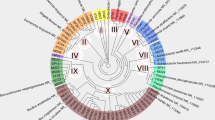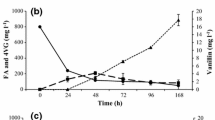Abstract
The worldwide contamination of cereals, oilseeds, and other crops by mycotoxin-producing moulds is a significant problem. Mycotoxins have adverse effects on humans and animals that result in illnesses and economic losses. Reduction or elimination of mycotoxin contamination in food and feed is an important issue. This study aimed to screen soil bacteria for degradation of zearalenone (ZEN). A pure culture of strain CK1 isolated from soil samples showed most capable of degradation of ZEN. Using physiological, biochemical, and 16S rRNA gene sequence analysis methods, CK1 was identified as Bacillus licheniformis. Addition of 2 ppm of ZEN in Luria–Bertani (LB) medium, B. licheniformis CK1 decreased 95.8% of ZEN after 36 h of incubation. In ZEN-contaminated corn meal medium, B. licheniformis CK1 decreased more than 98% of ZEN after 36 h of incubation. In addition, B. licheniformis CK1 was non-hemolytic, non-enterotoxin producing, and displayed high levels of extracellular xylanase, cellulase, and protease activities. These findings suggest that B. licheniformis CK1 could be used to reduce the concentrations of ZEN and improve the digestibility of nutrients in feedstuffs simultaneously.




Similar content being viewed by others
References
Alexopoulos C, Georgoulakis I, Tzivara A, Kyriakis CS, Govaris A, Kyriakis SC (2004a) Field evaluation of the effect of a probiotic-containing Bacillus licheniformis and Bacillus subtilis spores on the health status, performance, and carcass quality of grower and finisher pigs. J Vet Med A Physiol Pathol Clin Med 51:306–312
Alexopoulos C, Georgoulakis IE, Tzivara A, Kyriakis SK, Siochu A, Kyriakis SC (2004b) Field evaluation of the efficacy of a probiotic-containing Bacillus licheniformis and Bacillus subtilis spores, on the health status and performance of sows and their litters. J Anim Physiol Anim Nutr 88:381–392
Bata A, Lasztity R (1999) Detoxification of mycotoxin-contaminated food and feed by microorganisms. Trends Food Sci Technol 10:223–228
Bohm J, Grajewski J, Asperger H, Cecon B, Rabus B, Razzazi E (2000) Study on biodegradation of some A- and B-trichothecenes and ochratoxin A by use of probiotic microorganisms. Mycotoxin Res 16A:70–74
Claus D, Berkeley RCW (1986) Genus Bacillus Chon 1872. In: Sneath PHA, Mair NS, Sharpe ME, Holt JG (eds) Bergey’s manual of systematic bacteriology, vol 2. The Williams & Wilkins Co., Baltimore, pp 1105–1139
Desjardins AE, Proctor RH (2007) Molecular biology of Fusarium mycotoxins. Int J Food Microbiol 119:47–50
El-Nezami H, Polychronaki N, Salminen S, Mykkanen H (2002) Binding rather than metabolism may explain the interaction of two food-grade Lactobacillus strains with zearalenone and its derivative α-zearalenol. Appl Environ Microbiol 68:3545–3549
European Food Safety Authority (2009) Review of mycotoxin-detoxifying agents used as feed additives: mode of action, efficacy and feed/food safety. Available at: http://www.efsa.europa.eu/en/scdocs/doc/22e.pdf
From C, Pukall R, Schumann P, Hormazabal V, Granum PE (2005) Toxin-producing ability among Bacillus spp. outside the Bacillus cereus group. Appl Environ Microbiol 71:1178–1183
Guinebretiere MH, Broussolle V, Nguyen-The C (2002) Enterotoxigenic profiles of food-poisoning and food-borne Bacillus cereus strains. J Clin Microbiol 40:3053–3056
Hall TA (1999) BioEdit: a user-friendly biological sequence alignment editor and analysis. Nucleic Acids Symp Ser 41:95–98
Huang JM, La Ragione RM, Nunez A, Cutting SM (2008) Immunostimulatory activity of Bacillus spores. FEMS Immunol Med Microbiol 53:195–203
Hussein HS, Brasel JM (2001) Toxicity, metabolism, and impact of mycotoxins on humans and animals. Toxicology 167:101–134
International Agency for Research on Cancer (1993) Overall evaluations of carcinogenicity to humans. In: IARC Monographs, vol 56. International Agency for Research on Cancer, Lyons, France, pp 397–444
Kiessling KH, Pettersson H, Sandholm K, Olsen M (1984) Metabolism of aflatoxin, ochratoxin, zearalenone, and three trichothecenes by intact rumen fluid, rumen protozoa, and rumen bacteria. Appl Environ Microbiol 47:1070–1073
Kritas SK, Govaris A, Christodoulopoulos G, Burriel AR (2006) Effect of Bacillus licheniformis and Bacillus subtilis supplementation of ewe’s feed on sheep milk production and young lamb mortality. J Vet Med A Physiol Pathol Clin Med 53:170–173
Kyriakis SC, Tsiloyiannis VK, Vlemmas J, Sarris K, Tsinas AC, Alexopoulos C, Jansegers L (1999) The effect of probiotic LSP 122 on the control of post-weaning diarrhoea syndrome of piglets. Res Vet Sci 67:223–228
Mateo JJ, Llorens A, Mateo R, Jimenez M (2001) Critical study of and improvements in chromatographic methods for the analysis of type B trichothecenes. J Chromatogr A 918:99–112
Molnar O, Schatzmayr G, Fuchs E, Prillinger H (2004) Trichosporon mycotoxinivorans sp. Nov., a new yeast species useful in biological detoxification of various mycotoxins. Syst Appl Microbiol 27:661–671
Ouoba LII, Thorsen L, Varnam AH (2008) Enterotoxins and emetic toxins production by Bacillus cereus and other species of Bacillus isolated from Soumbala and Bikalga, African alkaline fermented food condiments. Int J Food Microbiol 124:224–230
Page RD (1996) TreeView: an application to display phylogenetic trees on personal computers. Comput Appl Biosci 12:357–358
Petchkongkaew A, Taillandier P, Gasaluck P, Lebrihi A (2008) Isolation of Bacillus spp. from Thai fermented soybean (Thua-nao): screening for aflatoxin B1 and ochratoxin A detoxification. J Appl Microbiol 104:1495–1502
Salkinoja-Salonen M, Vuorio R, Andersson MA, Kampfer P, Andersson MC, Honkanen-Buzalski T, Scoging AC (1999) Toxigenic strains of Bacillus licheniformis related to food poisoning. Appl Environ Microbiol 65:4637–4645
Silva CMG, Vargas EA (2001) A survey of zearalenone in corn using Romer Mycosep 224 column and high performance liquid chromatography. Food Addit Contam 18:39–45
Sorokulova IB, Pinchuk IV, Denayrolles M, Osipova IG, Huang JM, Cutting SM, Urdaci MC (2008) The safety of two Bacillus probiotic strains for human use. Dig Dis Sci 53:954–963
Statistical Analysis System Institute (1998) SAS User’s guide: statistics. SAS Institute Inc., Cary
Takahashi-Ando N, Kimura M, Kakeya H, Osada H, Yamaguchi I (2002) A novel lactonohydrolase responsible for the detoxification of zearalenone: enzyme purification and gene cloning. Biochem J 365:1–6
Teather RM, Wood PJ (1982) Use of Congo red-polysaccharide interactions in enumeration and characterization of cellulolytic bacteria from the bovine rumen. Appl Environ Microbiol 43:777–780
Thompson JD, Higgins DG, Gibson TJ (1994) CLUSTAL W: improving the sensitivity of progressive multiple sequence alignment through sequence weighting, positionspecific gap penalties and weight matrix choice. Nucleic Acids Res 22:4673–4680
Veith B, Herzberg C, Steckel S, Feesche J, Maurer KH, Ehrenreich P, Bäumer S, Henne A, Liesegang H, Merkl R, Ehrenreich A, Gottschalk G (2004) The complete genome sequence of Bacillus licheniformis DSM13, an organism with great industrial potential. J Mol Microbiol Biotechnol 7:204–211
Waldeck J, Daum G, Bisping B, Meinhardt F (2006) Isolation and molecular characterization of chitinase-deficient Bacillus licheniformis strains capable of deproteinization of shrimp shell waste to obtain highly viscous chitin. Appl Environ Microbiol 72:7879–7885
Weisburg WG, Brans SM, Pelletier DA, Lane DJ (1991) 16S ribosomal DNA amplification for phylogenetic study. J Bacteriol 173:697–703
Westlake K, Mackie RI, Dutton MF (1987) Effects of several mycotoxins on specific growth rate of Butyrivibrio fibrisolvens and toxin degradation in vitro. Appl Environ Microbiol 53:613–614
Wu QH, Jezkova A, Yuan ZH, Pavlikova L, Dohnal V, Kuca K (2009) Biological degradation of aflatoxins. Drug Metab Rev 41:1–7
Yiannikouris A, Francois J, Poughon L, Dussap CG, Bertin G, Jeminet G, Jouany JP (2004) Adsorption of zearalenone by beta-d-glucans in the Saccharomyces cerevisiae cell wall. J Food Protect 67:1195–1200
Zinedine A, Soriano JM, Molto JC, Manes J (2007) Review on the toxicity, occurrence, metabolism, detoxification regulations and intake of zearalenone: an oestrogenic mycotoxin. Food Chem Toxicol 45:1–18
Acknowledgments
The authors thank Professor Y. H. Cheng of National Ilan University for providing ZEN-contaminated corn meal. This research was conducted using funds partially provided by grant 98AS-2.1.4-AD-U1(9) and 99AS-2.1.4-AD-U1(5) from the Council of Agriculture, Republic of China.
Author information
Authors and Affiliations
Corresponding author
Rights and permissions
About this article
Cite this article
Yi, PJ., Pai, CK. & Liu, JR. Isolation and characterization of a Bacillus licheniformis strain capable of degrading zearalenone. World J Microbiol Biotechnol 27, 1035–1043 (2011). https://doi.org/10.1007/s11274-010-0548-7
Received:
Accepted:
Published:
Issue Date:
DOI: https://doi.org/10.1007/s11274-010-0548-7




